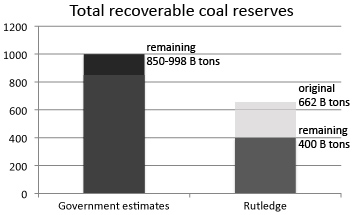Is peak coal coming sooner than we think?
Governments have greatly overestimated global coal reserves according to estimates presented by a geologist at the annual meeting of the American Geophysical Union in San Francisco.
David Rutledge, a professor of engineering at Caltech, estimates economically recoverable coal reserves at 400 billion tons worldwide. By comparison, governments claim 850 billion to 998 billion tons of recoverable coal.
Rutledge said that government estimates are outdated and overly optimistic. His own work is based on analysis of production data, using a technique pioneered by M. King Hubbert. Hubbert is now famous for predicting in 1956 that U.S. oil production would peak in 1970. He was off by one year.
 Estimates of global coal reserves |
Rutledge said advancements in technology — specifically mechanization of coal mining — have reduced the amount of coal that can be recovered economically. Deposits that were once dug by hand out of seams are today unexploitable by machinery. He said this is one of the rare cases where technology has a lower yield than manual labor.
While environmentalists may be pleased to hear that there is less coal to dig up and burn, other scientists at the AGU meeting said that there is still enough coal to boost atmospheric CO2 concentrations to unsafe levels. Further, unconventional fossil fuels like methane hydrates, tar sands, and oil shale are other carbon-intensive energy sources ripe for exploitation.
“There is far more than enough currently usable coal and other fossil fuels to push us past the threshold beyond which we would not want to go with the climate,” said Pushker Kharecha, a researcher at the NASA Goddard Institute for Space Studies (GISS) and Columbia University.
“Addressing the climate problem means addressing the coal problem,” added Dr. Ken Caldeira, a researcher at the Carnegie Institution’s Department of Global Ecology at Stanford University. “Whether there’s a little more oil or a little less oil will change the details, but if we want to change the overall shape of the warming curve, it matters what we do with coal.”







